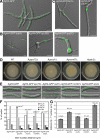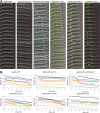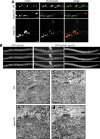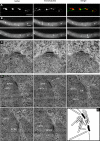Structural mutants of the spindle pole body cause distinct alteration of cytoplasmic microtubules and nuclear dynamics in multinucleated hyphae
- PMID: 20053682
- PMCID: PMC2828962
- DOI: 10.1091/mbc.e09-07-0555
Structural mutants of the spindle pole body cause distinct alteration of cytoplasmic microtubules and nuclear dynamics in multinucleated hyphae
Abstract
In the multinucleate fungus Ashbya gossypii, cytoplasmic microtubules (cMTs) emerge from the spindle pole body outer plaque (OP) in perpendicular and tangential directions. To elucidate the role of cMTs in forward/backward movements (oscillations) and bypassing of nuclei, we constructed mutants potentially affecting cMT nucleation or stability. Hyphae lacking the OP components AgSpc72, AgNud1, AgCnm67, or the microtubule-stabilizing factor AgStu2 grew like wild- type but showed substantial alterations in the number, length, and/or nucleation sites of cMTs. These mutants differently influenced nuclear oscillation and bypassing. In Agspc72Delta, only long cMTs were observed, which emanate tangentially from reduced OPs; nuclei mainly moved with the cytoplasmic stream but some performed rapid bypassing. Agnud1Delta and Agcnm67Delta lack OPs; short and long cMTs emerged from the spindle pole body bridge/half-bridge structures, explaining nuclear oscillation and bypassing in these mutants. In Agstu2Delta only very short cMTs emanated from structurally intact OPs; all nuclei moved with the cytoplasmic stream. Therefore, long tangential cMTs promote nuclear bypassing and short cMTs are important for nuclear oscillation. Our electron microscopy ultrastructural analysis also indicated that assembly of the OP occurs in a stepwise manner, starting with AgCnm67, followed by AgNud1 and lastly AgSpc72.
Figures









Similar articles
-
Mobility, microtubule nucleation and structure of microtubule-organizing centers in multinucleated hyphae of Ashbya gossypii.Mol Biol Cell. 2010 Jan 1;21(1):18-28. doi: 10.1091/mbc.e09-01-0063. Epub 2009 Nov 12. Mol Biol Cell. 2010. PMID: 19910487 Free PMC article.
-
Dynamics of multiple nuclei in Ashbya gossypii hyphae depend on the control of cytoplasmic microtubules length by Bik1, Kip2, Kip3, and not on a capture/shrinkage mechanism.Mol Biol Cell. 2010 Nov 1;21(21):3680-92. doi: 10.1091/mbc.E10-06-0527. Epub 2010 Sep 15. Mol Biol Cell. 2010. PMID: 20844079 Free PMC article.
-
Electron tomography of the microtubule cytoskeleton in multinucleated hyphae of Ashbya gossypii.J Cell Sci. 2012 Dec 1;125(Pt 23):5830-9. doi: 10.1242/jcs.111005. Epub 2012 Sep 26. J Cell Sci. 2012. PMID: 23015595
-
Role of NuMA in vertebrate cells: review of an intriguing multifunctional protein.Front Biosci. 2006 Jan 1;11:1137-46. doi: 10.2741/1868. Front Biosci. 2006. PMID: 16146802 Review.
-
Microtubule nucleation and establishment of the mitotic spindle in vascular plant cells.Plant J. 2013 Jul;75(2):245-57. doi: 10.1111/tpj.12179. Epub 2013 May 7. Plant J. 2013. PMID: 23521421 Review.
Cited by
-
Organization of organelles within hyphae of Ashbya gossypii revealed by electron tomography.Eukaryot Cell. 2013 Nov;12(11):1423-32. doi: 10.1128/EC.00106-13. Epub 2013 Jun 14. Eukaryot Cell. 2013. PMID: 23771903 Free PMC article.
-
Sporulation in Ashbya gossypii.J Fungi (Basel). 2020 Aug 29;6(3):157. doi: 10.3390/jof6030157. J Fungi (Basel). 2020. PMID: 32872517 Free PMC article. Review.
-
Clustering of nuclei in multinucleated hyphae is prevented by dynein-driven bidirectional nuclear movements and microtubule growth control in Ashbya gossypii.Eukaryot Cell. 2011 Jul;10(7):902-15. doi: 10.1128/EC.05095-11. Epub 2011 Jun 3. Eukaryot Cell. 2011. PMID: 21642510 Free PMC article.
-
Mechanism of nuclear movements in a multinucleated cell.Mol Biol Cell. 2017 Mar 1;28(5):645-660. doi: 10.1091/mbc.E16-11-0806. Epub 2017 Jan 11. Mol Biol Cell. 2017. PMID: 28077618 Free PMC article.
-
The SUN protein Mps3 is required for spindle pole body insertion into the nuclear membrane and nuclear envelope homeostasis.PLoS Genet. 2011 Nov;7(11):e1002365. doi: 10.1371/journal.pgen.1002365. Epub 2011 Nov 17. PLoS Genet. 2011. PMID: 22125491 Free PMC article.
References
-
- Ayad-Durieux Y., Knechtle P., Goff S., Dietrich F., Philippsen P. A PAK-like protein kinase is required for maturation of young hyphae and septation in the filamentous ascomycete Ashbya gossypii. J. Cell Sci. 2000;113:4563–4575. - PubMed
Publication types
MeSH terms
Substances
LinkOut - more resources
Full Text Sources
Miscellaneous

